Rheumatism, or rheumatic disorders, encompass a broad range of conditions causing chronic, often intermittent pain in the joints or connective tissue. This term does not specify a particular disorder but includes over 200 different conditions, such as arthritis and “non-articular rheumatism,” also known as “regional pain syndrome” or “soft tissue rheumatism.”
Rheumatism, as a general term, is characterized by inflammation or pain in muscles, joints, or fibrous tissue. One of the most common forms of this disorder is Rheumatoid arthritis. This condition can cause pain, swelling, and deformity in the joints. It is a chronic inflammatory disorder that can affect more than just the joints. In some individuals, it may also impact other parts of the body.
Rheumatic diseases broadly impact joints, tendons, ligaments, bones, and muscles. These include many types of arthritis, a term commonly used for conditions affecting the joints. Sometimes, they are referred to as “musculoskeletal diseases.” The term rheumatism itself is somewhat popular yet indefinite, often used to describe a variety of disorders marked by inflammation, degeneration, or metabolic derangement of connective tissue structures, with symptoms like pain, stiffness, or limited motion. These disorders encompass conditions such as osteoarthritis, bursitis, and sciatica.
The definition of rheumatism is rather broad, covering a medical condition that causes stiffness and pain in the joints, where two bones meet. To learn more about rheumatism and its various manifestations, refer to the comprehensive resources available at Wikipedia, Merriam-Webster, WebMD, Medical Dictionary, and Cambridge Dictionary.



